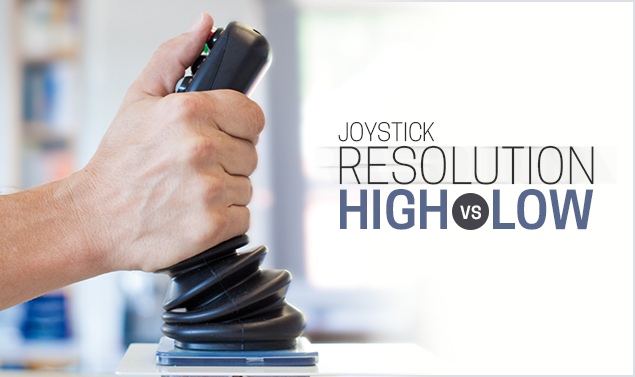
Let’s talk resolution. No, not for your phone or tablet screen. In this case, resolution is the distance a joystick handle moves compared to the value of the reference signal it outputs. In other words, it’s the degree of travel the joystick moves which then controls its intended function.
For example, moving a crane’s joystick forward would also move the crane forward. The higher the resolution, the more handle travel will be required to move the crane. The lower the resolution, the less handle travel will be required to make the same movement.
So what’s the difference? Which is better? Let’s break it down.
High Resolution
High-resolution joysticks are typically larger in size and hand-operated. The standard output resolution on this end of the spectrum has evolved over time to around 36°-0°-36°. Higher resolution enables more handle travel, which can help assure operational productivity, safety, and optimum control. This additional handle movement allows crane and industrial equipment operators to gradually increase and decrease the speed of the intended machinery function while minimizing unexpected sudden movements and overshot targets. High-resolution joysticks and controllers are the standard in port and mill applications where productivity is vital to everyday operations.
Low Resolution
Low-resolution joysticks are typically smaller in size and can be hand or finger-operated. These types of joysticks squeeze movement range from 26°-0°-26° or as low as 15°-0°-15°, and are well suited for mobile hydraulic applications.
Utilizing low-resolution joysticks for operating large industrial machinery, such as ship-to-shore cranes or crucible cranes, can make it difficult to control movement safely - leading to overshot targets, extra movements, and lower productivity. In addition, they typically require arm stabilization and a static position, which contributes to higher operator stress and possible injury.
Which Comes Out On Top?
Higher resolution offers greater control and more efficient operations. However, your resolution should be guided by your application.
Does your application have limited space? Choose a low-resolution, finger-operated joystick. Is your machinery prone to vibrations? A high-resolution, larger joystick is less prone to accidental engagement from heavy vibrations.
If you are thinking about switching from low to high or high to low resolution, don’t forget about muscle memory. Your operators have grown accustomed to whatever style of joystick they have regularly worked with, so radically changing the resolution will require relearning machinery operation.